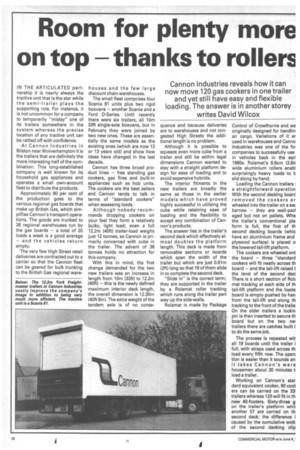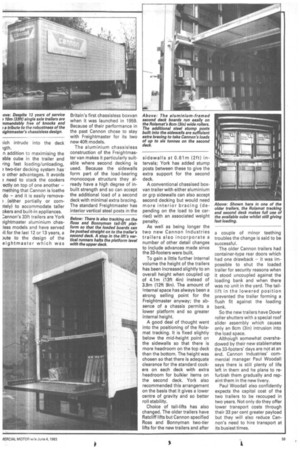Room for plenty more on top thanks to rollers
Page 60

Page 61

If you've noticed an error in this article please click here to report it so we can fix it.
Cannon Industries reveals how it can now move 120 gas cookers in one trailer and yet still have easy and flexible loading. The answer is in another storey writes David Wilcox
IN THE ARTICULATED partnership it is nearly always the tractive unit that is the star while the semi-trailer plays the supporting role. For instance, it is not uncommon for a company to temporarily "mislay" one of its trailers somewhere in the system whereas the precise location of any tractive unit can be rattled off with confidence.
At Cannon Industries in Bilston near Wolverhampton it is the trailers that are definitely the more interesting half of the combination. This long-established company is well known for its household gas appliances and operates a small own-account fleet to distribute the products.
Approximately 80 per cent of the production goes to the various regional gas boards that make up British Gas, which simplifies Cannon's transport operations. The goods are trunked to 28 regional warehouses run by the gas boards — a total of 20 loads a week is a good average — and the vehicles return empty.
The very few High Street retail deliveries are contracted out to a carrier so that the Cannon fleet can be geared for bulk trunking to the British Gas regional ware houses and the few large discount chain warehouses.
The small fleet comprises four Scania 81 units plus two rigid boxvans — another Scania and a Ford D-Series. Until recently there were six trailers, all 10m 33ft single-axle boxvans, but in February they were joined by two new ones. These are essentially the same models as the existing ones (which are now 12 or 13 years old) and show how ideas have changed in the last decade.
Cannon has three broad product lines — free standing gas cookers, gas fires and built-in appliances such as hob units. The cookers are the best sellers and Cannon tends to talk in terms of "standard cookers" when assessing loads.
Although nobody recommends dropping cookers on your feet they form a relatively bulky, light load; even a full 12.2m (40ft) trailer-load weighs just 12 tonnes, so Cannon is primarily concerned with cube in the trailer. The advent of 38 tonnes holds no attraction for this company.
With this in mind, the first change demanded for the two new trailers was an increase in length from 10m (33ft) to 12.2m (40ft) — this is the newly defined maximum interior deck length, the overall dimension is 12.35m (40ft ein). The extra weight of the tandem axle is of no conse quence and because deliveries are to warehouses and not congested High Streets the additional length is no problem.
Although it is possible to squeeze even more cube from a trailer and still be within legal dimensions Cannon wanted to stay with a straight platform design for ease of loading and to avoid expensive hybrids.
The interior fitments in the new trailers are broadly the same as those in the earlier models which have proved highly successful in utilising the cube while retaining ease of loading and the flexibility to accept any combination of Cannon's products.
The answer lies in the trailer's second deck which effectively almost doubles the platform length. This deck is made from removable sections or boards which span the width of the trailer but which are just 0.61m (2ft) long so that 19 of them slide in to complete the second deck.
"Slide in" is the correct term; they are supported in the trailer by a Rolamat roller tracking which runs along the trailer part way up the side-walls.
Rolamat is made by Package Control of Crowthorne and wa originally designed for handlin air cargo. Variations of it ar used in warehouses and Canno Industries was one of the fin companies to successfully use in vehicles back in the earl 1960s. Rolamat's 6.6cm (2.611 wide aluminium rollers enabl surprisingly heavy loads to t) slid along by hand.
Loading the Cannon trailers' a straightforward operatior With the second decking boarc removed the cookers ar wheeled into the trailer on a sac barrow — they are well-padl aged but not on pallets. Whe the trailer's conventional pla form is full, the first of th second decking boards (whic have an aluminium frame and plywood surface) is placed o the lowered tail-lift platform.
The cookers are wheeled ont the board — three "standard cookers will fit neatly across th board — and the tail-lift raised t the level of the second decl There is a short section of Rah mat tracking at each side of th tail-lift platform and the loade board is simply pushed by han from the tail-lift and along th tracking to the front of the traile On the older trailers a lockin pin is then inserted to secure th board but on the two nel trailers there are catches built i to do the same job.
The process is repeated wit all 19 boards until the trailer i full, with straps used across th load every fifth row. The °perk' tion is easier than it sounds an it takes Cannon's ware housemen about 30 minutes t load a trailer.
Working on Cannon's star dard equivalent cooker, 90 cool ers can be carried on the 33 trailers whereas 120 will fit in th new 40-footers. Sixty-three g on the trailer's platform whil another 57 are carried on th second deck; the difference i caused by the cumulative widt of the second decking clip lich intrude into the deck igth.
n addition to maximising the able cube in the trailer and ring fast loading/unloading, two-tier decking system has o other advantages. It avoids
need to stack the cookers .ectly on top of one another — mething that Cannon is loathe do — and it is easily remove: (either partially or corn:tely) to accommodate taller okers and built-in appliances. -..:annon's 33ft trailers are York .lightmaster aluminium chasless models and have served ill for the last 12 or 13 years, a )ute to the design of the eightmaster which was
Britain's first chassisless boxvan when it was launched in 1959. Because of their performance in the past Cannon chose to stay with Freightmaster for its two new 40ft models.
The aluminium chassisless construction of the Freightmaster van makes it particularly suitable where second decking is used. Because the sidewalls form part of the load-bearing monocoque structure they already have a high degree of inbuilt strength and so can accept the additional load of a second deck with minimal extra bracing. The standard Freightmaster has interior vertical steel posts in the sidewalls at 0.61m (2ft) intervals; York has added stump posts between these to give the extra support for the second deck.
A conventional chassised boxvan trailer with either aluminium or grp sidewalls can also accept second decking but would need more interior bracing (depending on the load to be carried) with an associated weight penalty.
As well as being longer the two new Cannon Industries trailers also incorporate a number of other detail changes to include advances made since the 33-footers were built.
To gain a little further internal volume the height of the trailers has been increased slightly to an overall height when coupled up of 4.1m (13ft 4in) instead of 3.9m (12ft 9in). The amount of internal space has always been a strong selling point for the Freightmaster anyway; the absence of a chassis permits a lower platform and so greater internal height.
A good deal of thought went into the positioning of the Rolamat tracking. It is fixed slightly below the mid-height point on the sidewalls so that there is more headroom on the top deck than the bottom. The height was chosen so that there is adequate clearance for the standard cookers on each deck with extra headroom for bulkier items on the second deck. York also recommended this arrangement on the basis that it gives a lower centre of gravity and so better roll stability.
Choice of tail-lifts has also changed. The older trailers have Ratcliff lifts but Cannon specified Ross and Bonnyman two-tier lifts for the new trailers and after a couple of minor teething troubles the change is said to be successful.
The older Cannon trailers had container-type rear doors which had one drawback — it was impossible to shut the loaded trailer for security reasons when it stood uncoupled against the loading bank and when there was no unit in the yard. The taillift in the lowered position prevented the trailer forming a flush fit against the loading bank.
So the new trailers have Dover roller shutters with a special roof slider assembly which causes only an 8cm (3in) intrusion into the load space.
Although somewhat overshadowed by their new stablemates the 33-footers' days are not at an end. Cannon Industries' commercial manager Paul Woodall says there is still plenty of life left in them and he plans to refurbish them gradually and repaint them in the new livery.
Paul Woodall also confidently expects the capital cost of the two trailers to be recouped in two years. Not only do they offer lower transport costs through their 33 per cent greater payload but they will also reduce Cannon's need to hire transport at its busiest times.
































































































